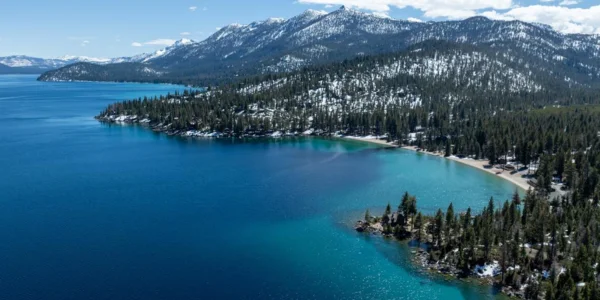Lake Tahoe is known for its breathtaking blue waters, snow-capped mountains, and outdoor recreation. Straddling the border of California and Nevada, it’s a favorite destination for tourists, hikers, skiers, and nature lovers. But beneath its serene surface lies a trove of chilling legends, mysterious phenomena, and terrifying truths. Here are 10 scary facts about Lake Tahoe that may change the way you see this iconic lake.
1. Lake Tahoe Is Incredibly Deep — and Cold

Lake Tahoe is the second-deepest lake in the U.S., with a maximum depth of 1,645 feet (501 meters). That’s deeper than the Empire State Building is tall. Its lower layers remain cold year-round (about 39°F or 4°C), making it extremely dangerous for swimmers. The cold temperatures can lead to cold water shock, which has caused many accidental drownings.
Scary Fact: Victims who drown in Lake Tahoe may never resurface, due to cold temperatures preventing normal decomposition and bloating.
2. It’s a Drowning Hotspot
Despite its peaceful appearance, Lake Tahoe has a high drowning rate. Between 2000 and 2023, over 100 people drowned in its waters, with many more near-death incidents recorded. Strong winds, sudden waves, and cold water immersion often catch even experienced swimmers and kayakers off guard.
Even on warm days, hypothermia can set in within minutes, especially in early summer when the snowmelt keeps the water frigid.
3. There Are Preserved Bodies in the Depths
Due to the lake’s cold temperatures and low oxygen levels at its deepest points, bodies in Lake Tahoe don’t decompose the same way they do elsewhere. Many believe the lake holds dozens of preserved corpses, some dating back decades — possibly even longer. Divers have occasionally reported seeing eerily intact human remains.
Lake myth or truth? Some speculate Mafia victims from Las Vegas were dumped here — an idea rooted more in lore than proven fact, but still chilling.
4. The “Tahoe Tessie” Legend Haunts Locals
Like Loch Ness has Nessie, Lake Tahoe has Tahoe Tessie — a sea serpent-like creature rumored to inhabit the lake. Sightings date back to the 19th century, with reports of a large, snake-like creature swimming below the surface. While no scientific proof exists, many locals and visitors claim to have seen something unexplained.
In 2023, a viral TikTok video appeared to show “something massive” moving under the surface — reigniting interest in Tessie.
5. Earthquake Activity Could Trigger a Tsunami
Lake Tahoe lies within a seismically active region. According to the USGS, a major earthquake could cause an underwater landslide, which in turn could trigger a tsunami-like wave in the lake. Geological studies suggest this has happened before — as recently as 4,500 years ago.
Fact: A 7.0+ magnitude earthquake could create waves up to 30 feet high, devastating lakeside communities.
6. Toxic Algae Blooms Are Increasing
Although Lake Tahoe is famed for its clarity, recent years have seen a rise in toxic algae blooms, especially in warmer summers. These cyanobacteria blooms can release harmful toxins, posing risks to pets, children, and wildlife. In 2022 and 2023, multiple beaches were temporarily closed due to high algae concentrations.
☣️ Swimming in bloom-affected areas can cause rashes, vomiting, and even liver damage in severe cases.
7. Dangerous Winds and Rogue Waves
Lake Tahoe’s high elevation (over 6,200 feet above sea level) means it’s exposed to sudden high winds that can create rogue waves and whitecaps on the lake. These unpredictable waves can easily capsize small boats or kayaks and have caught even experienced sailors off guard.
A storm in July 2021 caused sudden 40 mph gusts and overturned multiple boats — one person drowned.
8. Its Clarity Is Deceiving
The lake’s famed clarity, which in some areas reaches up to 70 feet, can create a false sense of security. Swimmers may underestimate how quickly the depth increases or how far they are from shore. The sudden transition from shallow to deep can induce panic — a dangerous condition in cold water.
⚠️ Tourists often report disorientation due to optical illusions created by the clear water.
9. Wildlife Hazards Are Real
While you might expect bears in the Tahoe region, few realize how bold and unpredictable they can be. Bears frequently enter residential neighborhoods, campgrounds, and even vacation homes in search of food. There have also been recent coyote and mountain lion sightings near the lake.
In 2023, viral videos showed a bear breaking into multiple cabins near South Lake Tahoe — with people still inside!
10. Pollution and Climate Change Are Threatening the Lake
Lake Tahoe’s environment is under threat from climate change, invasive species, and pollution. Rising temperatures are changing snowmelt patterns, and warmer water is encouraging algae growth and impacting native species. If the current trajectory continues, Tahoe’s legendary blue clarity could be lost within a generation.
️ According to the Tahoe Environmental Research Center, the lake’s average clarity declined 8 feet between 2018 and 2022.
Conclusion
Beneath the pristine postcard views of Lake Tahoe lies a darker, mysterious reality. From preserved bodies and seismic threats to underwater legends and environmental concerns, this seemingly tranquil lake is a place where beauty and danger coexist.
Whether you’re visiting for the first time or you’ve been coming for years, these scary facts about Lake Tahoe remind us that nature — no matter how beautiful — always demands respect.



